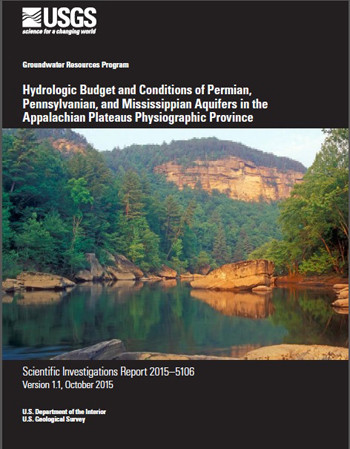
Product Details
- Product Number
- 424585
- Series
- SIR-2015-5106
- Scale
- NO SCALE
- Alternate ID
- SIR-2015-5106
- ISBN
- 978-1-4113-3930-9
- Authors
- DAVID L NELMS
- Version Date
- 01/01/2015
- Countries
- USA
- Media
- Paper
- Format
- Bound
Additional Details
- Description
-
Abstract
In response to challenges to groundwater availability posed by historic land-use practices, expanding development of hydrocarbon resources, and drought, the U.S. Geological Survey Groundwater Resources Program began a regional assessment of the Appalachian Plateaus aquifers in 2013 that incorporated a hydrologic landscape approach to estimate all components of the hydrologic system: surface runoff, base flow from groundwater, and interaction with atmospheric water (precipitation and evapotranspiration). This assessment was intended to complement other Federal and State investigations and provide foundational groundwater-related datasets in the Appalachian Plateaus.
A regional Soil-Water-Balance model was constructed for a 160 ,000-square-mile study area that extended to the topographic divide of all streams originating outside but flowing into areas underlain by Appalachian Plateaus aquifers. The model incorporated soil, landscape, and climate variables to estimate an annual water budget for the 32-year period from 1980 to 2011 and was calibrated using base-flow data estimated by hydrograph separation techniques from 20 streamflow gaging stations across the study area. Over this period, an average of 47 inches per year (in/yr) of precipitation fell on Appalachian Plateaus aquifers. Simulations from the regional Soil-Water-Balance model indicate that only 19 percent of the precipitation or an average 9 in/yr recharged aquifers, and 19 percent resulted in surface runoff to streams. The remaining 62 percent, an average of 27 in/yr of water, was returned to the atmosphere via evapotranspiration. Because withdrawals from aquifers due to pumping equated to less than 1 percent of the water budget, differences in predevelopment and postdevelopment regional water budgets of the Appalachian Plateaus were minimal. Storage changes caused by filling of abandoned coal-mine aquifers and long-term differences in aquifer storage resulting from climate fluctuations constitute a small portion of the overall water budget.
The percentage of precipitation that results in recharge, runoff, or evapotranspiration from the landscape varies annually by up to a factor of two depending on temporal changes in prevailing climate conditions and spatial changes in basin characteristics, precipitation patterns, and sources of atmospheric moisture over a large study area. A comparison of water-budget estimates from the regional Soil-Water-Balance model for a dry year (1988) and wet year (2004) showed that evapotranspiration accounts for most of the annual differences in precipitation. As a portion of annual precipitation, evapotranspiration ranged from 69 percent (dry year) to 52 percent (wet year), a range four times greater than the 15 percent (dry year) to 18 percent (wet year) range estimated for recharge. Evapotranspiration as a percentage of precipitation peaks during dry periods, whereas base flow and runoff tend to reach minimum values. During wet periods, this relationship is reversed and base flow and runoff as a percentage of precipitation generally peak while evapotranspiration percentages reach minimum values. Annual recharge in the Appalachian Plateaus reaches a maximum at near 20 percent of annual precipitation, regardless of the severity of wet conditions.
Hydrograph separation data from 849 streamflow gaging stations in the study area were used to assess trends in streamflow, base flow, surface runoff, and base-flow index, or ratio of base flow to streamflow, in the Appalachian Plateaus for the period from 1930 to 2011. Annual data anomalies for each of the four variables were individually defined as the annual standard deviation from the mean at all 849 streamflow gaging stations. Annual data anomalies confirm the close relation of annual precipitation to both base flow and runoff components of streamflow, and both components increased during the period of analysis. Around 1970, conditions shifted streamflow from values generally below to above long-term means. At a regional scale, increases in base flow account for most of these observed increases in mean annual streamflow. The independence of the base-flow index to annual climate trends indicate that changes in the components of streamflow of the Appalachian Plateaus are probably in response to shifts in seasonal precipitation or widespread land-use practices.
A subset of 77 index streamgages, defined as having 60 or more years of complete record between the years 1930 and 2011 with no more than 20 percent missing data, was selected to show spatial patterns of change in the water budget. Data from the index streamgages showed that the overall trends in base flow are dependent upon the period of evaluation. Long-term (1930–2011) increases in base flow were observed throughout the study area. For two shorter periods (1930–1969 and 1970–2011) trends in base flow were largely negative. In general, spatial patterns of change in streamflow, base flow, and runoff were mixed but generally consistent with prevailing climate patterns and land-use changes.
- Survey Date
- 2015
- Print Date
- 2015
- Height In Inches
- 11.000
- Length In Inches
- 8.500
- Two Sided
- Yes
- Pieces
- 1
- Languages
- English




